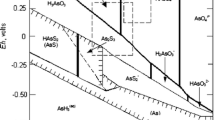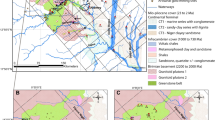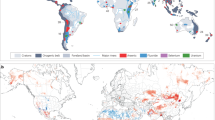Abstract
The Salí River Basin in north-west Argentina (7,000 km2) is composed of a sequence of Tertiary and Quaternary loess deposits, which have been substantially reworked by fluvial and aeolian processes. As with other areas of the Chaco-Pampean Plain, groundwater in the basin suffers a range of chemical quality problems, including arsenic (concentrations in the range of 12.2–1,660 μg L−1), fluoride (50–8,740 μg L−1), boron (34.0–9,550 μg L−1), vanadium (30.7–300 μg L−1) and uranium (0.03–125 μg L−1). Shallow groundwater (depths up to 15 m) has particularly high concentrations of these elements. Exceedances above WHO (2011) guideline values are 100% for As, 35% for B, 21% for U and 17% for F. Concentrations in deep (>200 m) and artesian groundwater in the basin are also often high, though less extreme than at shallow depths. The waters are oxidizing, with often high bicarbonate concentrations (50.0–1,260 mg L−1) and pH (6.28–9.24). The ultimate sources of these trace elements are the volcanic components of the loess deposits, although sorption reactions involving secondary Al and Fe oxides also regulate the distribution and mobility of trace elements in the aquifers. In addition, concentrations of chromium lie in range of 79.4–232 μg L−1 in shallow groundwater, 129–250 μg L−1 in deep groundwater and 110–218 μg L−1 in artesian groundwater. All exceed the WHO guideline value of 50 μg L−1. Their origin is likely to be predominantly geogenic, present as chromate in the ambient oxic and alkaline aquifer conditions.





Similar content being viewed by others
References
Astolfi, E., Besuschio, S. C., García, J. C., Guerra, C., & Maccagno, A. (1982). Hidroarsenicismo Crónico Regional Endémico (p. 144). Buenos Aires, Argentina: Edit. Coop. General Belgrano.
Astolfi, E. A. N., Maccagno, A., García Fernández, J. C., Vaccaro, R., & Stimola, R. (1981). Relation between arsenic in drinking water and skin cancer. Biological Trace Element Research, 3, 133–143.
Ayerza, A. (1917a). Arsenicismo regional endémico (keratodermia y melanodermia combinadas). Bol. Acad. Medicina 2–3 (pp. 11–24). Buenos Aires, Argentina.
Ayerza, A. (1917b). Arsenicismo regional endémico (keratodermia y melanodermia combinadas) (continuación). Bol. Acad. Medicina 2–3 (pp. 41–55). Buenos Aires, Argentina.
Ayerza, A. (1918). Arsenicismo regional endémico (keratodermia y melanodermia combinadas). Bol. Acad. Nac. Medicina I (pp. 11–41). Buenos Aires, Argentina.
Bates, M. N., Rey, O. A., Biggs, M. L., Hoppenhayn, C., Moore, L. E., Kalman, D., et al. (2004). Case–control study of bladder cancer and exposure to arsenic in Argentina. American Journal of Epidemiology, 159, 381–389.
Besuschio, S. C., Desanzo, A. C., Pérez, A., & Croci, M. (1980). Epidemiological associations between arsenic and cancer in Argentina. Biological Trace Element Research, 2, 41–55.
Bhattacharya, P., Claesson, M., Bundschuh, J., Sracek, O., Fagerberg, J., Jacks, G., et al. (2006). Distribution and mobility of arsenic in the Río Dulce alluvial aquifers in Santiago del Estero Province, Argentina. Science of the Total Environment, 358, 97–120.
Bundschuh, J., Farias, B., Martin, R., Storniolo, A., Bahattacharya, P., Cortes, J., et al. (2004). Groundwater arsenic in the Chaco-Pampean Plain, Argentina: case-study from Robles County, Santiago del Estero Province. Applied Geochemistry, 19(2), 231–243.
Bundschuh, J., García, M. E., & Bhattacharya, P. (2006). Arsenic in groundwater of Latin America—a challenge of the 21st century. Geological Society of America Annual Meeting, Philadelphia, 22–25 Oct. 2006, Geological Society of America Abstracts with Programs, 38:7 (320 pp.).
Bundschuh, J., Perez Carrera, A., & Litter, M. (Eds.). (2008). Distribución del arsénico en las regiones Ibérica e Iberoamericana (223 pp.). Buenos Aires, Argentina: Editorial Programa Iberoamericano de Ciencia y Tecnología para el Desarrollo. Available at: http://www.cnea.gov.ar/xxi/ambiental/iberoarsen/.
Cabrera, H. N., & Gómez, M. L. (2003). Skin cancer induced by arsenic in the water. Journal of Cutaneous Medicine and Surgery, 7(2), 106–111.
Círculo Médico del Rosario. (1917). Sobre la nueva enfermedad descubierta en Bell-Ville. Revista Médica del Rosario, VII (pp. 485). Rosario, Argentina.
de la Sota, M., Puche, R., Rigalli, A., Fernández, M. L., Benassati, S., & Boland, R. (1997). Modificaciones de la masa ósea y en la homeóstasis de la glucosa en residentes de la zona de Bahía Blanca con alta ingesta de flúor. Medicina, 57, 417–420. Buenos Aires, Argentina.
del Razo, L. M., Arellano, M. A., & Cebrián, M. E. (1990). The oxidation states of arsenic in well-water from a chronic arsenicism area of northern Mexico. Pollution, 64, 143–153.
Dzombak, D. A., & Morel, F. M. M. (1990). Surface complexation modeling: Hydrous ferric oxide (p. 393). New York: Wiley.
Farías, S. S., Casa, V. A., Vazquez, C., Ferpozzi, L., Pucci, G. N., & Cohen, I. M. (2003). Natural contamination with arsenic and other trace elements in ground waters of Argentine Pampean Plain. Science of the Total Environment, 309, 187–199.
Florentino, C. E., Paoloni, J. D., Sequerra, M. E., & Arosteguy, P. (2007). The presence of vanadium in groundwater of southeastern extreme the Pampean region Argentina: Relationship with other chemical elements. Journal of Contaminant Hydrology, 93, 122–129.
Fujii, R., & Swain, W. C. (1995). Areal distribution of selected trace elements, salinity, and major ions in shallow ground water, Tulares Basin, southern San Joaquin Valley, California (67 pp.). US geological survey water-resources investigations report, 95-4048. Denver, USA: US Geological Survey.
García, M. G., Moreno, C., Galindo, M. C., Hidalgo, M. del V., Fernández, & Sracek, O. (2009). Intermediate to high levels of arsenic and fluoride in deep geothermal aquifers from thr northwestern Chaco-Pampean plain, Argentina. CRC Press/Balkema. In J. Bundschuh, M. A. Armienta, P. Birkle, P. Bhattacharya, J. Matschullat, & A. B. Mukherjee (Eds.), Natural arsenic in groundwater of Latin America—occurrence, health impact and remediation (pp. 69–79). Balkema, Boca Raton: CRC Press.
Hopenhayn-Rich, C., Biggs, M. L., Fuchs, A., Bergoglio, R., Tello, E., Nicolli, H., et al. (1996). Bladder cancer mortality associated with arsenic in drinking water in Córdoba, Argentina. Epidemiology, 7, 117–124.
Nicolli, H. B., Suriano, J. M., Gómez Peral, M. A., Ferpozzi, L. H., & Baleani, O. M. (1989). Groundwater contamination with arsenic and other trace elements in an area of the Pampa, Province of Córdoba, Argentina. Environmental Geology and Water Sciences, 14, 3–16.
Nicolli, H. B., Tineo, A., Falcón, C. M., & García, J. W. (2005). Distribución del arsénico y otros elementos asociados en aguas subterráneas de la región de Los Pereyra, provincia de Tucumán, Argentina. In G. Galindo, J. L. Fernández Turiel, M. A. Parada, & D. Gimeno Torrente (Eds.), Arsénico en aguas: origen, movilidad y tratamiento (pp. 83–92). Río Cuarto, Argentina: IV Cong. Argentino de Hidrogeología.
Nicolli, H. B., Tineo, A., Falcón, C. M., García, J. W., Merino, M. H., Etchichury, M. C., Alonso, M. S., & Tofalo, O. R. (2008). Hydrogeochemistry of arsenic in groundwaters from Burruyacú basin, Tucumán Province, Argentina. In J. Bundschuh, M. A. Armienta, P. Bhattacharya, J. Matschullat, & A. B. Mukherjee (Eds.), Natural arsenic in groundwaters of Latin America—Occurrence, health impact and remediation. In J. Bundschuh, & P. Bhattacharya (series Eds.), Arsenic in the environment (Vol. 1, pp. 47–59). Leiden, The Netherlands: CRC Press, Balkema.
Nicolli, H. B., Tineo, A., Falcón, C. M., & Merino, M. H. (2001). Movilidad del arsénico y de otros oligoelementos asociados en aguas subterráneas de la cuenca de Burruyacú, provincia de Tucumán, República Argentina. In A. Medina, J. Carrera, & L. Vives (Eds.), Congreso Las Caras del Agua Subterránea I (pp. 27–33). Madrid: Instituto Geológico y Minero de España.
Nicolli, H. B., Tineo, A., & García, J. W. (2000). Estudio hidrogeológico y de calidad del agua en la cuenca del río Salí, provincia de Tucumán. Revista Association Argentina Geología Aplicada a la Ingeniería y al Ambiente, 15, 82–100. Buenos Aires, Argentina.
Nicolli, H. B., Tineo, A., García, J. W., Falcón, C. M., Merino, M. H., Etchichury, M. C., et al. (2004). The role of loess in groundwater pollution at Salí River Basin, Argentina. In R. B. Wanty & R. R. Seals II (Eds.), Water–rock interaction (2nd ed., pp. 1591–1595). Leiden, The Netherlands: Balkema.
Oscarson, D. W., Huang, P. M., Defosse, D., & Herbillion, A. (1981a). Oxidative power of Mn(IV) and Fe(III) oxides with respect to As(III) in terrestrial and aquatic environments. Nature, 291, 50–51.
Oscarson, D. W., Huang, P. M., & Liaw, W. K. (1981b). Role of manganese in the oxidation of arsenite by freshwater lake sediments. Clays & Clay Minerals, 29, 219–225.
Parkhurst, D. L., & Appelo, C. (1999). User’s guide to PHREEQC (Version2)—A computer program for speciation, batch-reaction, one-dimensional transport, and inverse geochemical calculations. U.S. Geol. Survey Water-Resources Investigations, Report 99–4259. Denver, USA: US Geological Survey.
Smedley, P. L., Kinniburgh, D. G., Macdonald, D. J. M., Nicolli, H. B., Barros, A. J., Tullio, J. O., et al. (2005). Arsenic associations in sediments from the loess aquifer of La Pampa, Argentina. Applied Geochemistry, 20(5), 989–1016.
Smedley, P. L., Nicolli, H. B., Macdonald, D. M. J., Barros, A. J., & Tullio, J. O. (2002). Hydrogeochemistry of arsenic and other inorganic constituents in groundwaters from La Pampa, Argentina. Applied Geochemistry, 17(3), 259–284.
Smedley, P. L., Nicolli, H. B., Macdonald, D. M. J., & Kinniburgh, D. G. (2008). Arsenic in groundwater and sediments from La Pampa province, Argentina. In J. Bundschuh, M. A. Armienta, P. Birkle, P. Bhattacharya, J. Matschullat, & A. B. Mukherjee (Eds.), Natural arsenic in groundwater of Latin America—occurrence, health impact and remediation (pp. 35–45). Boca Raton: CRC Press, Balkema.
Tello, E. (1951). Hidroarsenicismo Crónico Regional Endémico (HACRE), sus manifestaciones clínicas (p. 165). Córdoba, Argentina: Ed. Univ. Nac. de Córdoba.
Tineo, A. (1998). Los acuíferos del cono aluvial del río Salí, provincia de Tucumán, República Argentina. IV Cong. Latinoamericano de Hidrología Subterránea I (pp. 14–24). Uruguay: Montevideo.
Tineo, A., García, J., Falcón, C., D’Urso, C., & Rodríguez, G. (1995). Hidrogeología del cono aluvial del río Salí, provincia de Tucumán, Argentina. IX° Cong. Latinoamericano de Geología II (pp. 515–524). Venezuela: Caracas.
Tineo, A., Iglesias, E., Durán, M., Verma, M., García, J., Falcón, C., et al. (1989). Geochemical survey of the Llanura Tucumana geothermal area, Argentina. Geothermal Resources Council Transactions, XIII, 165–171.
WHO—World Health Organization. (2011). Guidelines for drinking-water quality. Fourth Edition. On line: http://www.who.int/publications/2011/9789241548151_eng.pdf.
Acknowledgments
The authors wish to acknowledge CONICET, Consejo Nacional de Investigaciones Científicas y Técnicas (Argentine National Council for Scientific and Technical Research) for providing additional funding from PIP N° 5775 as support for the research. Arturo J. Barros assisted in chemical analysis of waters, sediments and volcanic glasses.
Author information
Authors and Affiliations
Corresponding author
Rights and permissions
About this article
Cite this article
Nicolli, H.B., García, J.W., Falcón, C.M. et al. Mobilization of arsenic and other trace elements of health concern in groundwater from the Salí River Basin, Tucumán Province, Argentina. Environ Geochem Health 34, 251–262 (2012). https://doi.org/10.1007/s10653-011-9429-8
Received:
Accepted:
Published:
Issue Date:
DOI: https://doi.org/10.1007/s10653-011-9429-8




